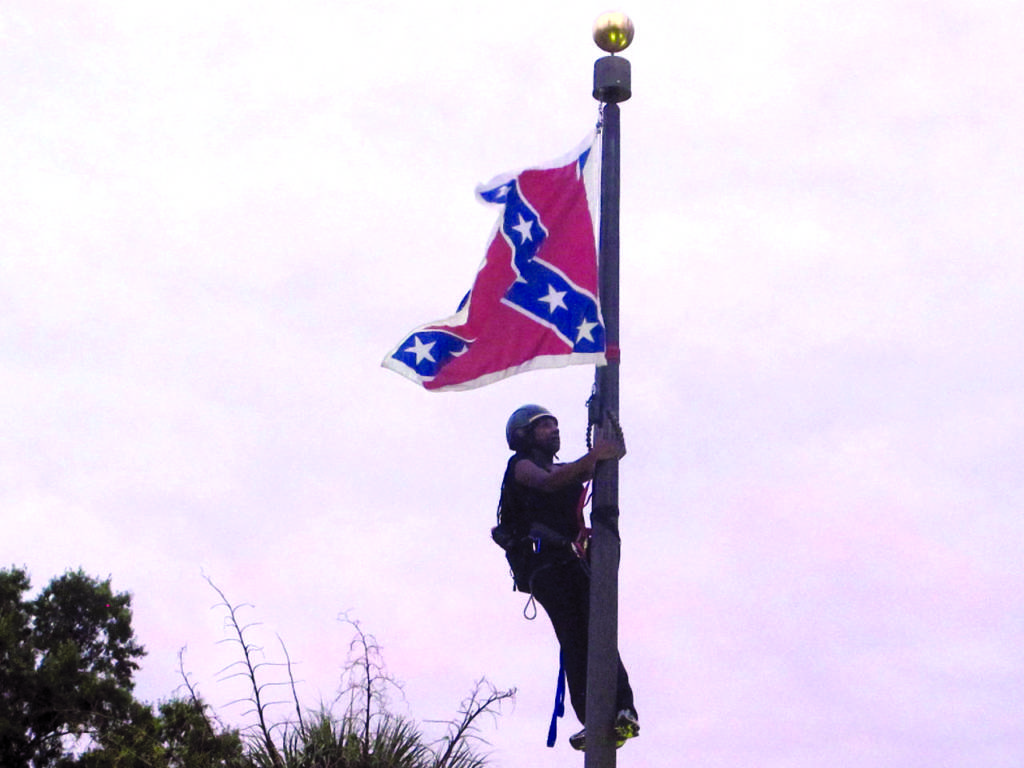“This is where my grandfather shot and killed the Yankee soldier trying to rob us,” the retired colonel said, pointing out a bullet hole in the woodwork of his entry hall. All of us were local Boy Scouts who had come to view this proud exhibit of local resistance to Union soldiers. It was 1970. I was fifteen. We were learning the Southern narrative of the Confederacy and looked on the bullet hole with reverence.
Lest we forget our heritage, a bronze Confederate soldier stood atop a fifty foot limestone plinth on the town square. Above him flapped the Confederate flag. This combination our monument to local men who had given their lives fighting to protect the South from the perfidious Yankees.
In the winter of 1865 Union soldiers had invaded South Carolina, leaving a fifty-mile wide swath of devastation as they cut their way through the state. Our handful of gallant Confederate cavalrymen nipped at their flanks but could not even slow them down. Plantations, farms, towns and cities in their path were pillaged then burned to the ground, my hometown included. Before crossing into South Carolina from Georgia, the commanding general, William Tecumseh Sherman, had told his men, “We are not fighting armies but a hostile people, and must make old and young, rich and poor, feel the hard hand of war.”
South Carolina suffered from devastation by Union troops as no other place in the United States ever had — or ever will. Food supplies seized or destroyed. Plough horses killed and dumped into wells to poison the water. Worst of all, the Union soldiers pulled up railroad tracks, heated them in bonfires, then twisted them around trees which made the rails impossible to salvage or repair. “Sherman’s bowties” they were called. South Carolina’s economy collapsed.
So harsh was the Union’s retribution on the state, which precipitated the Civil War by being the first to secede, that the story of General William Tecumseh Sherman and the atrocities of his men have passed down through generations.
The trauma of the Confederate defeat cut to the bone of the South, especially in my native South Carolina. When the fighting stopped in April 1865 and the Confederacy collapsed, 260,000 white Southern males lay dead. This is an unprecedented casualty rate in American history. Of the dead, 21,000 were South Carolinians, almost one-third of the state’s young men.
How could white Southerners come to an acceptance of the hurricane of violence which had passed over them, leaving a trail of destruction never imagined and a burden of grief heavier than Atlas ever had to lift?
White Southerners had to look for a noble reason to explain why so many of their sons had been sacrificed on the altar of war. That reason could not be the preservation of slavery. But the Civil War was about preserving slavery. And in the South, the institution of slavery had been as brutal, and as violent and as filled with hopelessness as the labor camps of the Soviet gulag or konzentrationslägers of Nazi Germany.
Our Confederate dead, the several hundreds of thousands of our golden youths, could not have perished for such an ignoble cause. So another reason had to be created: the South had fought the Civil War to secure Southern independence from the North. It is this misinformation which forms the foundation of the Myth of the Lost Cause. The constant repetition of this myth constituted my Confederate indoctrination.
What about the 3.5 million blacks held in slavery? How did that number fit into the myth? It didn’t. A lie was created to cover-up this inconvenient fact and the lie was this: only a handful of white Southerners owned slaves. Given that more than a third of Southern households owned slaves (reaching 50 percent in South Carolina and Mississippi) this lie was a whopper. But it was critical. How could our men have died in the cause of preserving slavery if so few of them owned slaves? And the handful of wealthy men who owned slaves hardly owned a total of 3.5 million, an obvious exaggeration by people who despised the South.
When I grew older and left South Carolina to attend college, I started to read deeply into unbiased histories of the Civil War. My Confederate indoctrination slowly began to melt away. I rejected my idolization of the Confederacy, dropped out of the Sons of Confederate Veterans and admitted the truth to myself: the South started the Civil War to preserve the unspeakable evil of black slavery, with South Carolina leading the way.
Only when the Myth of the Lost Cause is finally broken to pieces will white Southerners move past their reverence for the Confederacy. Only then will they accept the reality and moral imperative of African-American equality.




